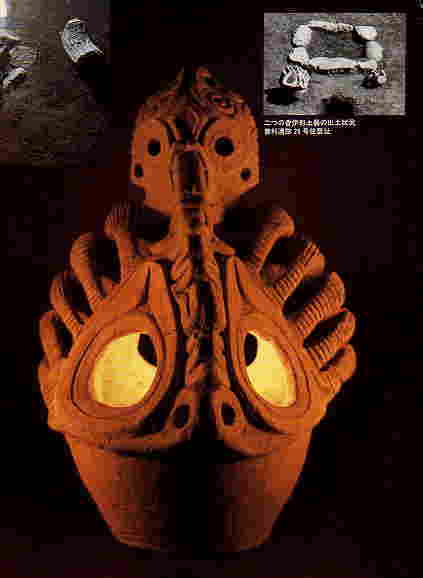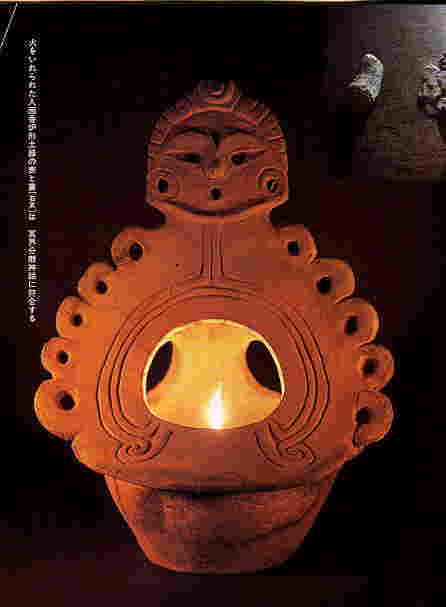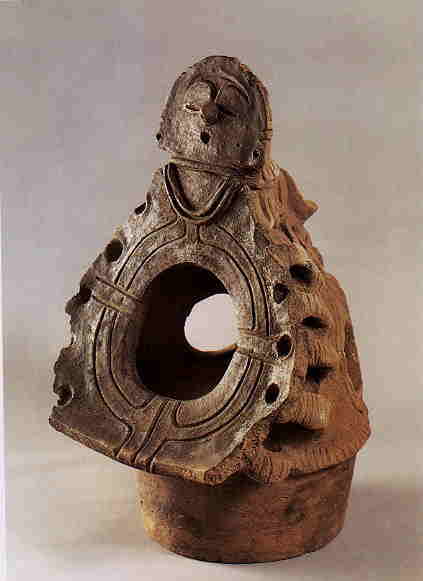Below: Sori Site in Fujimi-Cho, Nagano Prefecture
Front Back
Above: Gotenba Site in Ina City,
Nagano
Prefecture


The
earthenware vessels above were excavated
in Nagano Prefecture, belonging to the Jomon
Chuuki (the Middle Stage). Sot, oil stains
and burns inside and outside prove that
they were used as a lamp, and apparently
were used hung down by their hangers. There
are several lamps of similar designs excavated in other Jomon Chuuki sites.
This type of lamp is named "earthenware
with a hanger". Archaeologists
have concluded this type was used at rituals,
as itsbody is covered with elaborate patterns.and the number of lamps of this type so far
found is by far smaller than that of other
lamps of simpler designs. Unlike broken
clay dolls, most of them were excavated whole,
which tells they were treated carefully.
As
you see, they have a female face at
the top, and the bodies show they are pregnant,
so when fire was lit at rituals, they
were women who were carrying fire in
their body.
It
is very interesting to note that people from
East Asia through islands on the South
Pacific Ocean to America had and have the
same type of goddesses in their myths. Again,
as I did when I wrote about "Broken
Clay Dolls", I'd like to quote from
the books by Professor Atsuhiko Yoshida, whose theories
I find most fascinating and convincing.
Professor Yoshida introduces similar myths
of a goddess told among several tribes, in
which she bears fire and her fire becomes
available to human beings.
First,
in Japanese mythological books, Kojiki and Nihon Shoki, there appears a goddess named Izanami, who
gave birth to a fire god Kagutsuchi after
she had borne Japanese Islands and
many gods and goddesses. and passed away
because of the burns she got during the bearing.
A
Melanesian tribe on Trobriand Island has
a story about a goddess who is the mother
of the sun and the moon as well as fire.
She lives with her younger sister,
and they live on wild yam potato the younger
sister gathers. While the elder one
sleeps peacefully every night after eating
her yam cooked on fire she hides in herself,
the younger one eats it raw and has a bad
night with coughing. One day the younger
sister pretends to go out looking for yam
and hides herself in the house. She
sees her elder sister take out fire from
between her legs and cook yam. Knowing
that her secret was out, the elder one suggests
that the secret be kept to themselves and
they monopolize fire. But the younger
sister has a different idea and sets fire
on many trees so that all human beings can
use it. Thus, the fire taken out from
between the legs of the mother goddess of
the sun and the moon in the ancient times
has spread over the world and all people
can have cooked food now.
A
tribe in the southern part of Guyana in South
America, Tarma, also has a similar story
about the origin of fire. There lived
only two brothers, Agigeco and Duido, living
on the earth at the genesis of time. One
day an otter told the brothers that they
had to fish up a woman from a chasm at the
bottom of a river if they want her. The
younger brother Duido fished the woman up
while Agigeco was sleeping tired from fishing
for a few days. Duido achieved the
woman and they became the parents of all
the human beings. Soon the brothers
found that the woman ate only cooked food
whereas they ate everything raw. They
asked her, but she wouldn't tell them how
she could cook food. One day,
after many years had passed, Agigeco visited
his brother's house. As soon as he left the
house for home late in the afternoon, he
noticed he had forgot his bag and asked his
brother's wife to bring the bag to him. Agigeco
asked her to come closer to hand it to him,
and when she came to him, he caught her and
said that if she didn't tell him how to cook
food, he would rape her. So she sat
down with her legs wide open and pressed
her belly hard. Then a fireball rolled
out of her birth canal. At first Agigeco
couldn't use the fire, as it had lost its
magic when it left the woman, but he mixed
pepper, bark and nuts with the fire and made
it burn.
An
anthropologist Taira Ohbayashi also
refers to many more myths where a goddess
bears fire, spreading widely in many
areas. According to Ohbayashi, fire comes
out from between legs on the Newguinea Islands;
from the vagina in North Australia; from
all parts of woman on the Marquises
Islands (Polynesia); from woman's fingers
in New Zealand; from woman's body in North
Brazil; and from the vagina in Guyana.
The
range of places where these myths are told
corresponds to that of Hainuwele myths in which food comes out of a goddess's
body. All important things for human
beings to survive, such as food and fire,
were born from woman, Jomon people as well
as people in other regions in ancient times
thought.
A Goddess Who Bears Fire
